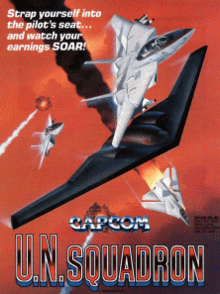U.N. Squadron
| U.N. Squadron | |
|---|---|
 Sales flyer for the arcade version | |
| Developer(s) | Capcom |
| Publisher(s) | Capcom |
| Composer(s) | Manami Matsumae |
| Platform(s) | Arcade, Amiga, Amstrad CPC, Atari ST, Commodore 64, SNES, ZX Spectrum |
| Release |
August 1989 SNES |
| Genre(s) | Scrolling shooter |
| Mode(s) | Single-player |
| Cabinet | Upright |
| Arcade system | CPS-1 |
| Display | Raster, 384 x 224 pixels (Horizontal), 4096 colors |
U.N. Squadron is a 1989 side-scrolling shooting game released by Capcom for the CPS arcade hardware and for the Super Nintendo Entertainment System. The game was released in Japan as Area 88 (Japanese: エリア88 Hepburn: Eria Hachi-Jū-Hachi),[1] and is based on the manga series of the same name, featuring the same main characters. Here, their mission is to stop a terrorist group known as Project 4. It was followed by a spiritual successor Carrier Air Wing.
Gameplay
.png)
The game is a typical side scrolling shooter, going against the trend of other Capcom shooters, such as 1942, and 1943: The Battle of Midway, which are vertically scrolling shooters. However, like other Capcom shooters, the player has an energy bar that is consumed over the course of a single life as the player sustains damage. This trait is highly uncommon among other comparable arcade-style shooters which normally use a system of reserve lives, where one of which is lost upon a single enemy hit. Before entering a level, the player can purchase special weapons or added defenses in the shop. The player earns money to buy weapons by destroying enemy planes and vehicles during levels and, when the level is finished, any unused weapons are converted back into money.
The player can choose between three mercenary pilots: Shin Kazama, Mickey Simon, and Greg Gates. Each pilot flies a specific plane and has slightly different capabilities.
The game was converted to the Super Nintendo Entertainment System and Super Famicom in 1991. Unlike in the arcade version, each pilot can use a range of planes. All pilots start out with $3000 and the basic F8 Crusader, and can buy other aircraft and weapons as they progress.
Release
Area 88 was ported to the home console Super Nintendo and released in Japan on July 26 1991.[1] In America and Europe it was re-titled UN Squadron.
Reception
Upon release, the Japanese gaming publication Famitsu gave the Super Famicom (Super Nintendo) version a 28 out of 40 score.[1]
IGN ranked U.N. Squadron 37th on its "Top 100 Super Nintendo Games" list,[4] which made it the highest ranking side scroller shooter game on that list.
Entertainment Weekly gave the game an A and wrote that "U.N. Squadron is the kind of game cynical journalists had in mind when they derided the gulf conflict as the 'Nintendo war.' Set in the desert kingdom of 'Aslan,' it has players flying punitive strikes against air, sea, and ground military targets. The combat scenes are dizzying, the explosions crisp, and the sound effects awesome. In short, U.N. Squadron is a Pentagon planner's fantasy: a high-tech, low-casualty aerial assault that's over as soon as you turn off your TV set."[5] Entertainment Weekly picked the game as the #12 greatest game available in 1991, saying: "This lively battle game may not score points for political correctness, involving as it does a multinational air assault against a small Middle Eastern country. But the graphics, sound, and game play are good enough to wear down anyone's pacifist tendencies."[6]
References
- 1 2 3 4 "エリア88 [スーパーファミコン] / ファミ通.com". www.famitsu.com. Archived from the original on 2018-06-30. Retrieved 2018-07-26.
- ↑ "Super NES Games" (PDF). Nintendo. Archived from the original (PDF) on 2015-10-25. Retrieved 2012-07-25.
- ↑ "U.N. Squadron Release Data". GameFAQs. Archived from the original on 2013-08-09. Retrieved 2013-06-15.
- ↑ "UN Squadron - #37 Top 100 SNES Games - IGN". Archived from the original on 2017-09-01. Retrieved 2017-09-01.
- ↑ "{title}". Archived from the original on 2016-06-05. Retrieved 2018-09-09.
- ↑ "{title}". Archived from the original on 2017-02-19. Retrieved 2018-09-09.
External links
- U.N. Squadron at Arcade-History
- Area 88 at the Killer List of Videogames
- U.N. Squadron at the Killer List of Videogames
- U.N. Squadron at MobyGames
- UN Squadron SNES review from Mean Machines Archive